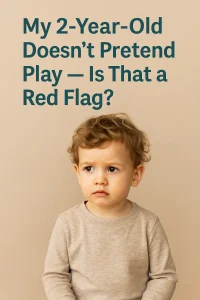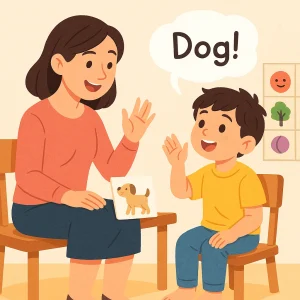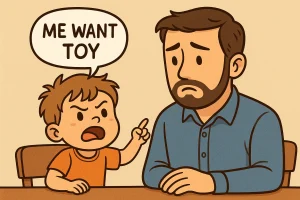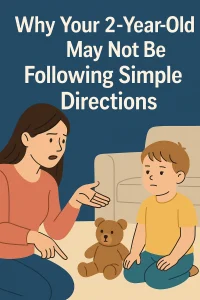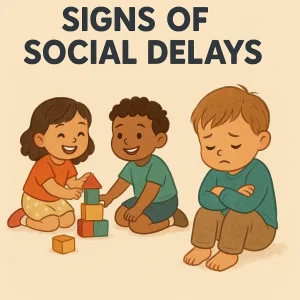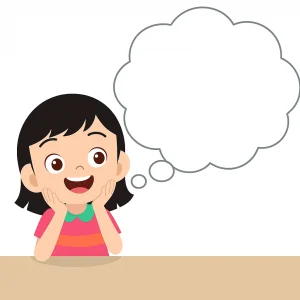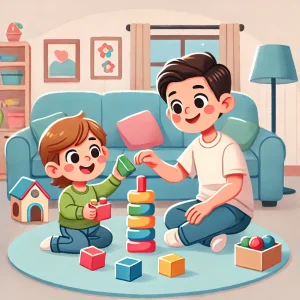Early Signs of Autism in Children: 7 Key Indicators
Last Updated: February 7, 2025
If you’ve ever wondered about the early signs of autism in children, you’re not alone. Autism Spectrum Disorder (ASD) affects how children communicate, interact, and learn. Since autism is a spectrum, no two children experience it the same way. Some may struggle with social skills, while others rely on routines or show unique behaviors. Understanding these early signs is crucial for timely intervention and support.
Why Recognizing Early Signs Matters
Developmental Milestones & Differences
Every child grows at their own pace, and as a parent, you might have already noticed how differently children develop. Some may walk before they turn one, while others might say their first words a little later. These variations are entirely normal. But sometimes, certain behaviors might hint at something more. Understanding these developmental differences is crucial in recognizing the early signs of autism.
For example, while some children might naturally be a bit more reserved or quiet, a consistent lack of response to their name by the time they’re around 12 months old or not showing interest in social games (like peek-a-boo) could be indicators worth paying attention to. Similarly, if you notice behaviors such as repetitive movements (like rocking or hand-flapping) or a strong preference for routines, these could be potential signs of Autism Spectrum Disorder (ASD).
Recognizing these early signs helps you differentiate between a child who is simply developing at their own pace and a child who might benefit from a little extra support. It’s not about jumping to conclusions or worrying unnecessarily— it’s about observing, being proactive, and staying informed.
Intervention Benefits: Why Early Support is Key
Spotting these signs early on isn’t just about making a diagnosis— it’s about helping your child reach their full potential. Early intervention can make a world of difference. Think of it like giving your child the right tools to navigate their world more confidently and comfortably. When recognized early, interventions such as speech therapy, occupational therapy, and social skills training can significantly improve a child’s ability to communicate, build relationships, and manage behaviors.
Research shows that children who receive early support are more likely to develop strong language skills, build better social interactions, and develop adaptive behaviors. The goal is to support the child in achieving their developmental milestones, in their own unique way. For example, if a child struggles with verbal communication, early speech therapy can enhance their ability to express themselves, while occupational therapy can help develop sensory processing skills and motor coordination.
Developmental Milestones and ASD Signs
| Typical Development Milestone | |
| By 6 months: Makes eye contact, smiles at familiar faces, babbles and coos, responds to sounds around them. | Limited or no eye contact, does not smile at familiar faces, limited babbling or vocal sounds, little reaction to sounds. |
| By 9 months: Smiles or shows joy when seeing a parent or caregiver, begins to use gestures like reaching out or pointing, imitates sounds or movements. | Rarely smiles at familiar people, limited or no use of gestures like pointing or reaching, does not imitate sounds or movements |
| By 12 months: Responds to their name, understands simple words like “no” or “bye-bye,” waves or claps hands, enjoys interactive games (e.g., peek-a-boo). | Does not respond to their name consistently, shows little understanding of simple words, limited or absent use of waving, clapping, or interactive play. |
| By 18 months: Uses simple words (e.g., “mama,” “dada”), follows simple instructions (e.g., “come here”), shows interest in playing with toys or other children. | Limited use of single words or speech sounds, struggles to follow simple instructions, shows little interest in toys or other children, prefers playing alone. |
| By 24 months (2 years): Combines two words (e.g., “want milk”), enjoys imitative play (e.g., pretend cooking or talking on the phone), understands more complex instructions like “put the ball on the table.” | No two-word phrases or very limited speech, does not engage in pretend play, difficulty understanding and following multi-step instructions. |
| By 36 months (3 years): Uses simple sentences, engages in back-and-forth conversations, shows a range of emotions (happy, sad, surprised), enjoys playing with other children. | Uses very few words or sentences, does not engage in conversations or respond to questions, limited emotional expression, prefers repetitive or solitary play over interacting with other children. |
7 Key Indicators of Autism to Watch For
Identifying the signs of Autism Spectrum Disorder (ASD) can feel like piecing together a puzzle, but when you understand what to look for, the picture becomes clearer. Here are seven key indicators that may help you recognize if your child is on the autism spectrum:
a. Delayed Speech or Language Skills
Is your child taking longer than expected to speak their first words? While children develop speech at different rates, delays in language skills are often one of the first signs of autism in children. This could include:
- Minimal babbling or sounds during infancy.
- Limited vocabulary or struggling to form words and sentences.
- Difficulty in expressing needs or desires verbally, making it hard to communicate thoughts or feelings.
It’s not just about “talking late”— it could also involve challenges in using language to interact with others. If your child has trouble expressing their needs or responds in ways that seem unusual, it might be a cue to dig deeper.
b. Lack of Eye Contact or Social Interaction
If you find that your child rarely looks you in the eyes, even when you’re talking to them, or doesn’t seem interested in social games like peek-a-boo, this could be an indicator of ASD. Children with autism may:
- Avoid eye contact during interactions.
- Show a lack of interest in playing with other kids or even adults.
- Struggle to smile back at you or respond to social cues, like their name being called.
Eye contact is an essential part of non-verbal communication, and its absence might be a sign that your child finds social interaction challenging.
c. Repetitive Behaviors and Restricted Interests
Does your child repeat the same movements or seem fixated on a particular toy or topic? Repetitive behaviors are another common sign of autism and can look like:
- Hand-flapping, rocking, or spinning.
- Insistence on routines or certain ways of doing things, like lining up toys in a particular order.
- Strong interests or obsessions with specific topics, objects, or even parts of objects (like wheels on a toy car).
These actions are often a form of self-soothing or focusing on something comforting to them. It’s not just “quirky” behavior; it could indicate a deeper preference for predictability and repetition.
d. Difficulty Understanding Social Cues or Emotions
If your child seems to have a hard time picking up on other people’s emotions or struggles with understanding facial expressions, it may be a sign of autism. Some behaviors to watch for include:
- Trouble interpreting body language or understanding social cues.
- Challenges in sharing interests or playing “pretend” games.
- A lack of showing empathy or difficulty recognizing how others feel.
For example, your child might not understand when someone is happy, sad, or upset, or may not know how to respond appropriately to different social situations.
e. Unusual Sensory Responses
Does your child seem overly sensitive to certain sounds, lights, or textures, or perhaps, not sensitive enough? Many children on the autism spectrum show either hypersensitivity or hyposensitivity to sensory stimuli, such as:
- Covering ears to block out noises that seem too loud or overwhelming.
- Showing strong aversions to certain textures, like clothing tags or specific foods.
- Little to no reaction to pain or physical sensations that might normally bother other children.
Children with autism may find comfort in certain sensory experiences or, conversely, find them highly distressing.
f. Lack of Gestures or Non-Verbal Communication
Gestures like pointing, waving, or nodding are all critical aspects of how young children communicate before they can speak fluently. If your child rarely uses gestures to communicate or has trouble understanding them, it could indicate ASD. Look for:
- Not pointing to objects of interest or to direct your attention to something.
- Limited use of gestures like waving goodbye, clapping, or nodding/shaking their head.
- Challenges with imitating others’ actions or facial expressions.
Non-verbal communication is often the first step in social interaction, and its absence can be a key sign of ASD.
g. Challenges with Changes in Routine
Does your child find it difficult to adapt to changes in their daily routine or environment? Children on the autism spectrum often prefer strict routines and may feel upset when faced with unexpected changes. For example:
- Distress when following a different route to school.
- Insistence on rituals, like having their bedtime routine followed exactly the same way every night.
- Difficulty transitioning from one activity to another.
What to Do if You Notice These Signs
Realizing that your child might show signs of Autism Spectrum Disorder (ASD) can be overwhelming. But remember, taking action early can lead to the best outcomes. Here’s a step-by-step guide to help you navigate the process if you notice any early signs of autism.
Observation & Documentation: The Power of Noticing Patterns
You know your child better than anyone else, so trust your instincts. Start by observing their behaviors, noting any patterns or developmental concerns that catch your attention. Keep track of details like:
- When your child responds to social cues and when they don’t.
- How they communicate their needs (verbally and non-verbally).
- Any repetitive behaviors or sensory sensitivities you notice.
Maintaining a simple journal or log of these observations over time can be extremely helpful. It doesn’t have to be elaborate— just enough to capture key behaviors and moments. This record will not only help you see any recurring patterns but also provide invaluable information to healthcare professionals.
Consult a Specialist: Seeking Professional Guidance
If your observations lead you to feel concerned, it’s important to seek advice from a professional. Don’t hesitate to talk to your pediatrician, who can help assess whether a comprehensive evaluation is needed. You can also reach out to specialists such as:
- Child psychologists or developmental pediatricians, who have expertise in identifying developmental differences.
- Speech-language pathologists or occupational therapists, who can further assess communication and sensory needs.
Early detection is crucial because it opens the door to early intervention, which can make a tremendous difference in how your child navigates social interactions, communication, and daily life.
Early Intervention Support: How Therapy Can Help
If a specialist confirms a diagnosis of ASD or suggests developmental delays, early intervention is the next big step. Therapies and support services can be tailored to meet your child’s unique needs and strengths. Some of the common early intervention options include:
- Speech Therapy: Helps children develop communication skills, be it through verbal language or alternative communication methods like sign language or picture cards.
- Occupational Therapy: Assists in developing daily living skills (like dressing and feeding), sensory processing abilities, and motor coordination.
- Applied Behavior Analysis (ABA): Aims to improve specific behaviors, such as social skills, communication, and learning through positive reinforcement.
- Social Skills Training: Encourages development in areas like turn-taking, playing with peers, and understanding social cues.
Understanding That Every Child is Unique
Every child is different, and just because you notice certain behaviors doesn’t mean your child is on the autism spectrum. It’s important to remember that while there are key indicators of Autism Spectrum Disorder (ASD), not all children with ASD will display the same signs. Similarly, some behaviors that may seem like indicators of autism can also be seen in children without ASD—particularly during specific developmental phases.
Emphasizing Individual Differences
Think of children as unique in their growth, interests, and communication styles. One child with autism may have delayed speech but be highly social, while another may communicate verbally but avoid eye contact or struggle with sensory sensitivities. And then there are children who might develop a bit later than others but catch up on their own. It’s about recognizing patterns over time rather than reacting to a single behavior.
Sometimes children have quirks, like preferring specific routines or being shy around strangers, which can be a part of their individual personalities and not necessarily a sign of autism. The key is to observe a combination of behaviors that are persistent and seem to affect their daily lives, social interactions, or communication.
Avoiding Self-Diagnosis: Why Consulting a Professional is Key
It can be tempting to jump to conclusions or self-diagnose your child based on information online or even your own observations. However, self-diagnosis can lead to unnecessary anxiety or misunderstanding. Instead, if you have concerns, it’s always best to consult a specialist who can give a professional evaluation. Pediatricians, child psychologists, and developmental specialists have the experience to conduct thorough assessments and provide an accurate diagnosis.
Seeking support isn’t about labeling your child—it’s about understanding their needs and how you can best support their growth and development. An accurate diagnosis paves the way for access to early intervention programs, specialized therapies, and valuable resources that can enhance your child’s development. Wellness Hub provides access to experienced professionals who can guide you in this journey, ensuring that every step you take is informed and supportive of your child’s individual path.Conclusion
Frequently Asked Questions:
1. What are the early signs of autism in children?
Early signs of autism in children may include delayed speech, limited eye contact, repetitive behaviors, difficulty understanding social cues, unusual sensory responses, lack of gestures or non-verbal communication, and challenges with changes in routine. Recognizing these signs early on can help with timely intervention.
2. How can I tell if my child is on the autism spectrum?
If you notice persistent signs like difficulty communicating, limited social interaction, repetitive behaviors, or sensitivity to sensory experiences, it may be helpful to consult a pediatrician or developmental specialist. Remember that each child is unique, and a professional can provide the best guidance.
3. At what age do autism symptoms typically appear?
Autism symptoms can appear as early as 12 to 18 months, but they may become more noticeable as your child grows. Every child develops at their own pace, so it’s important to observe consistent patterns of behavior over time.
4. Can a child outgrow signs of autism?
While autism is a lifelong condition, early intervention and tailored support can significantly improve communication, social skills, and behavior management. With the right resources and therapies, many children on the spectrum can develop skills that help them thrive.
5. What should I do if I notice autism symptoms in my child?
Start by documenting your observations and discussing them with a pediatrician or child specialist. They can perform developmental screenings and recommend early intervention therapies, such as speech therapy or occupational therapy, to support your child’s development.
6. Are repetitive behaviors always a sign of autism?
Not necessarily. Repetitive behaviors can be a normal part of childhood development, but if these behaviors persist, become intense, or interfere with daily activities, they may indicate autism. Consulting a specialist can help you understand the context of these behaviors.
7. Can autism be diagnosed at an early age?
Yes, autism can often be diagnosed as early as 18 months, but it can sometimes be recognized even earlier. The sooner a child is diagnosed, the earlier they can benefit from therapies and interventions designed to support their growth and learning.
8. How do I support my child if they are diagnosed with autism?
Support for children with autism includes early intervention through therapies like speech therapy, occupational therapy, and social skills training. Encouraging play, building routines, and fostering a supportive environment at home can also greatly benefit your child’s development.
9. Can some children show signs of autism without actually having the condition?
Yes, certain behaviors like delayed speech or repetitive actions can occur in children without autism. However, if you notice a combination of signs that persist over time, it’s a good idea to seek professional evaluation to understand your child’s needs better.
10. What role does early intervention play in a child’s development with autism?
Early intervention is crucial as it provides specialized support to help children with autism develop communication skills, social interactions, and adaptive behaviors. Therapies introduced early can have a significant positive impact on a child’s developmental journey.
About the Author:
Anuradha Karanam
Speech-language pathologist (7+ years of experience)
Anuradha Karanam is a certified PROMPT Therapist with over 6 years of experience. Fluent in Tamil, Telugu, Hindi, and English, she specializes in parent counseling, speech sound disorders, fluency assessment, and speech-language evaluations. Anuradha excels at working with children with developmental disorders, offering creative and effective therapy programs. Currently, at Wellness Hub, she holds a BASLP degree and is registered with the RCI (CRR No A85500). Her patience, ambition, and dedication make her a trusted expert in her field.
Book your Free Consultation Today
Parent/Caregiver Info:
Client’s Details:
* Error Message
